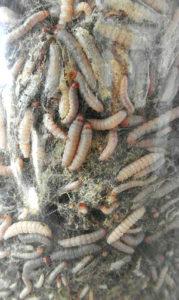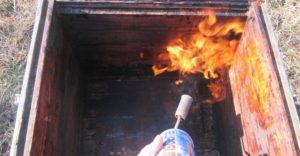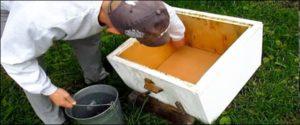Bee moth: larvae and butterflies of a harmful insect
Wax moth is usually associated with benefits and healing properties. There is a lot of information about its extraordinary benefits for the human body. But there is no good without bad. This expression is true in this case, because this butterfly has all its miraculous properties only thanks to bees. Here she acts as a pest, unceremoniously bursting into their homes and causing a lot of inconvenience with her presence.
Content
What does wax moth look like (photo)
Description of the pest
Name: Great wax moth, Bee moth
Latin: Galleria mellonella.Class: Insects - insecta.
Squad: Lepidoptera - Lepidoptera.
Family: Fireflies - Pyralidae.
 | Habitats: | hive |
 | Dangerous for: | bees |
 | Means of destruction: | folk, salt, vinegar, formic acid |
The bee moth is a representative of butterflies of the moth family. A sexually mature individual is able to lay more than 1 thousand eggs.
The wingspan of a large wax moth is up to 30 millimeters, the small wax moth has a wingspan of up to 20 millimeters and is not common.
The life expectancy of an adult female is on average 10 days, and that of a male is 25 days.
Hatching from the shell, the caterpillars gnaw long tunnels in the combs and weave a web there, leave their excrement, destroying the cells.
Sometimes it comes to the point that the hive becomes uninhabitable, and the bee colony leaves it.
Signs of the appearance of a wax moth
The fire moth cannot go unnoticed by the eyes of an experienced beekeeper. Even in the absence of clear signs, the behavior of bees can tell a lot.
- During infection, the swarm throws all its strength into the fight against larvae.
- They fly more slowly or cluster near the entrance, but do not fly out.
- Cobweb threads are visible on the bodies, and larvae thrown out of the cage can be found near the hive.
- If you look inside, then at the bottom you can see waste not only from honeycombs or bee products, but also the remains of adults and larvae that did not survive in the confrontation.
The short answer is yes. But there are a number of factors that can tip the scales in one direction or another - the immunity of bees, the season, the number of pests.
Due to the fact that the larvae produce the enzyme cerrase, they began to be used in medicine. It is widely used in the treatment of bronchial and cardiac problems. However, this is not a call for self-treatment!
How to get rid of wax moth
Fighting the wax moth moth is a rather painstaking task that requires regularity and versatility.
There are many different methods of prevention and treatment. Sulfur fumigation, folk remedies, chemical and physical, thermal treatment are widely used. However, to achieve the result, it is not enough to use only one of the methods. Combining several types of neutralization is more efficient and effective.
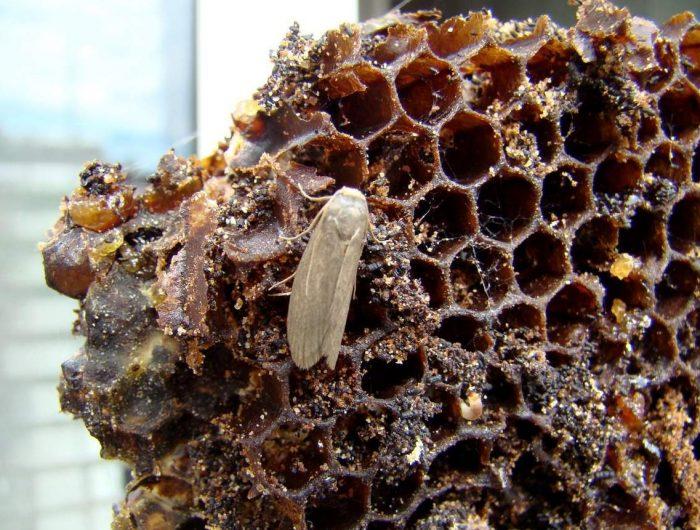
Fire butterfly.
Physical methods of struggle
It is known that adults, caterpillars and eggs do not tolerate temperatures above 50 and below 10 degrees Celsius. Therefore, some beekeepers roast honeycombs for an hour or freeze them for up to 2 hours. The exception is honeycombs with bee bread: they cannot be frozen.
To prevent the frames from molding, in the hot season they are hung at a distance in well-lit and ventilated rooms. For metal and wood structures in the hive, burnt with a blowtorch is used.
Chemical methods of struggle
There are various preparations for spraying and spraying, disinfection and tablets. Means in the plates are placed between the frames. After the plates are weathered, they are replaced with fresh ones.
When using chemicals, you must follow the rules of personal safety and use personal protective equipment, and at the end of work, wash your hands well with soap and water.
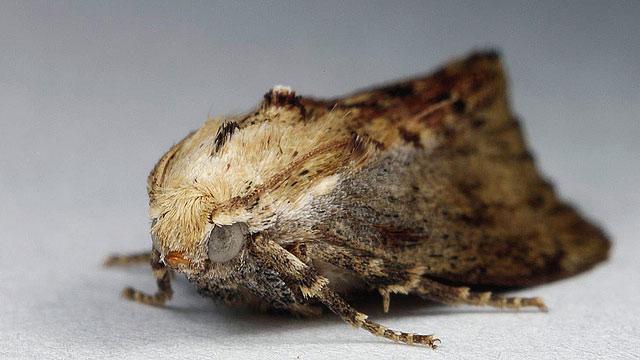
Wax moth.
Folk ways against moths
Unlike specialized chemicals, folk remedies are less effective and are more likely to be used to prevent getting rid of pests.
Their undoubted advantage is safety for both humans and bees, because a good half of special equipment destroys not only pests, but also honey plants. Also among the advantages - their availability and low cost.
Salt
In frames that are processed with ordinary food salt, butterflies do not start. After the honeycombs are freed from honey, you can start processing.
To do this, prepare a strong saline solution, spray the frames on both sides and leave to dry completely. After drying, excess salt is removed. Before installing the frame back into the hive, it is sprayed with water.
Formic acid
Formic acid tends to slow down decomposition processes. Processing with this tool begins after pumping out the honey and ends a week before its main collection.
To do this, cardboard plates are impregnated with formic acid and placed in plastic bags, hermetically packed, bending the upper edge twice. Before use, holes up to 1,5 centimeters in diameter are made in them. The bags are placed on the frames above the bee nest so that the holes are at the bottom.
To treat a bee swarm, an acid bag is placed in the hive, covered and insulated.
In the table below, there are more active and inexpensive folk remedies., which will help get rid of moths without harming the bees.
| Strawberry soap and lemon or orange peels | As you know, citrus peels spread a bright aroma that moths cannot stand. Such a repellent will reliably protect things and textiles from uninvited guests and flavor items in the closet. |
| Black and allspice, tobacco, cloves, rosemary | The spicy smell of allspice and other spices effectively repels moths and creates an unfavorable environment for breeding offspring. |
| Laundry soap | Potato and clothes moths cannot live normally and produce offspring if laundry soap is nearby. |
| Vinegar and garlic | Diluted vinegar is often used to treat cabinets as a preventive measure. Boxing garlic cloves works the same way. Butterflies do not tolerate persistent fragrant root. |
| Fir oil | The study of essential oils showed that fir oil was effective in the fight against domestic insects. The oil is applied to a cotton pad and wiped over surfaces where traces of moths were seen. |
| caucasian chamomile | Such a tool is used in dry form - a sachet of several grams is made and laid out around the apartment. |
| Chestnuts | Dried chestnuts are used to spread clothes and home textiles, thus preventing the appearance of butterflies. |
| Indoor plants coleus (nettle) and geranium (pelargonium) | These indoor flowers have a bright aroma that insects do not tolerate. Flowers scattered around the room will scare away insects and will not give comfort for reproduction. |
| Lavender | The fastest way to get rid of moths and other pests in the house is lavender and its oil. It has long been known to keep sprigs in all wardrobes, and to use lavender oil on surfaces and upholstered furniture. |
| Sagebrush | The smell of wormwood twigs has an unusual property: it is able to disorient adult moths in space, so the life cycle is disrupted and the pests disappear. |
| Газеты | Printing ink is known to repel insects. So, things placed in newspapers will remain untouched by harmful insects. |
| Vinegar | To treat surfaces with vinegar, two tablespoons are heated, then the hot liquid is placed in a cabinet for about 10 minutes. This time is enough to kill both larvae and adults with acid vapors. |
Ways to deal with moth larvae
Detecting and quickly responding to moth larvae in the honey industry prevents spread and makes decontamination more efficient. The bee brood, falling into the web, previously left by the wax moth, dies. Adult bees, trying to help young ones, also get into the web and immobilize.
The whole catch is that due to the presence of bees in the hive, it is dangerous to use many chemical means of control for their lives.
Having found a moth nest in the hive, the bees are moved to others, and the hive itself is treated with a blowtorch. Therefore, we get rid of the larvae by removing the infected frames from the hive, sweeping the caterpillars from them.
Then soak the honeycombs in water and leave for a day. Remove from water and let dry in the sun. Return the cleaned frame to its place or to an uninfected hive.
preventive measures
In order to save yourself from such a problem, it is recommended to maintain order and cleanliness not only in the hives, but also throughout the apiary.
- All hives must be in good condition.
- In places for storing honeycombs, the temperature should not exceed 10 degrees, well ventilated.
- The room should be fumigated with sulfur once every two weeks.
- Regularly replace the frames in the hives, damaged ones must be immediately disposed of.
- Beeswax is recommended to be stored in a tightly closed container.
Conclusion
For all their usefulness to humans, moth larvae are completely useless and even harmful neighbors in the bee house. In order not to waste precious time and effort on fighting and destroying, it is better to carry out a timely preventive set of procedures, thanks to which danger can be easily prevented.
Previous